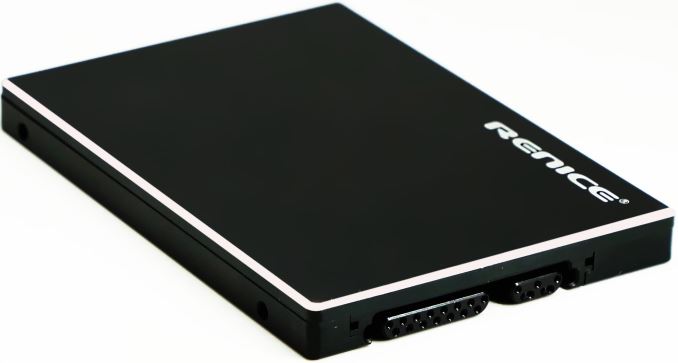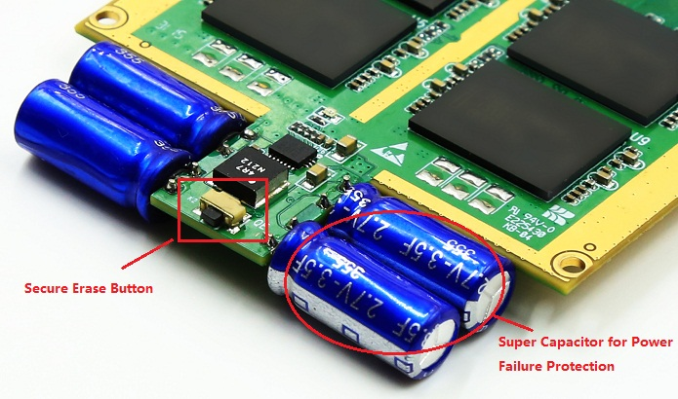Renice Announces X9 Military-Grade Rugged SSDs with R-SATA Connectors
by Anton Shilov on March 25, 2016 12:00 PM EST
Shenzhen Renice Technology, a little-known maker of special-purpose SSDs from China, has introduced its new family of drives designed for military and rugged applications. What makes these new drives notable is that they are designed to withstand harsh environments, utilizing special R-SATA connectors as well as custom controllers. On the NAND side the drives are build around SLC, MLC or pseudo-SLC NAND flash memory to provide the required balance between endurance, price and performance.
The Renice X9 R-SATA SSDs are powered by the company’s own controller, the RS3502-IT, as well as SLC or MLC NAND flash memory from undisclosed manufacturers. The drives are made in accordance with the MIL-STD-810F spec to withstand harsh environments and poor handling, and feature integrated power failure protection as well as 256-bit AES encryption with several secure erase functions (both software and hardware). The Renice X9 SSDs use the company’s proprietary 15-pin R-SATA connectors as well as special 7-pin SATA power ports, which limits compatibility of the drives to applications that feature the same connectors.
The SLC-based X9 R-SATA drives are offered in 128 GB – 1 TB configurations, whereas MLC-powered SSDs are available with 256 GB – 2 TB capacities. If required, Renice can use MLC NAND in pseudo-SLC mode in order to provide higher endurance and performance at a predictable cost. The Renice X9 comes in 2.5” form-factor with 7, 9 or 15 mm thickness, depending on the exact capacity configuration.
The manufacturer claims that the X9 SSDs have maximum sequential read speed of up to 530 MB/s and maximum sequential write speed of up to 500 MB/s along with 0.1 ms access time. The company does not specify random read/write performance of the drives, but claims that it is “excellent”. Keeping in mind that X9 SSDs can use different types of NAND flash memory and come in various configurations, random I/O performance of different models is likely to vary greatly.
| X9 2.5" R-SATA SSD Specifications | ||
| Renice X9 | ||
| Capacity | 128 GB - 1 TB (SLC) 256 GB - 2 TB (MLC) |
|
| Type of NAND | SLC MLC pseudo-SLC |
|
| Controller | RS3502-IT | |
| Interface | R-SATA (proprietary) 6 Gbps | |
| Form-Factor | 2.5" 7/9/15 mm | |
| Maximum sequential read/write | 530/500 MB/s | |
| DRAM Cache | Supported | |
| AES | 256-bit | |
| Overvoltage Protection | + | |
| Power Loss Protection | Yes, features four supercapacitors | |
| Secure Erase | Hardware and Software | |
| MTBF | 4 Million Hours | |
| ECC | 80 bits at 1024 | |
| Vibration | 16 G (10 - 2000 Hz) | |
| Shock | 1500 G at 0.5 ms half sine wave | |
| Humidity | 5 - 95% | |
| Operating Temperatures | -40ºC ~ +85ºC (industrial) -55ºC ~ +120ºC |
|
| Power Consumption | 10 W (2 TB) | |
With regards to reliability, the Renice X9 drives boast a MTBF of over four million hours, while their physical tolerance is rated for 16.4G (10 – 2000 Hz) sustained vibration and 1500G (@ 0.5 ms half sine wave) shock, something that typical drives simply do not offer (Intel's DC S3710 SSD, by comparison, can tolerate 2.17 G operating vibration and can survive 1000 G shock). The X9 SSDs are designed for operating temperatures ranging from -40°C to +85°C (industrial-grade) or even -55°C to+125°C (military-grade), which is in line with other SSDs for extreme environments (such as those from Amtron or Foremay). Meanwhile, datacenter drives like the DC S3710 can operate when its temperature is between 0ºC and +70ºC.
Given that Renice is a Shenzhen-based company, it is admittedly unlikely that the X9 SSDs will be used in military or defence applications outside of China. Nonetheless, since the drives are designed to withstand harsh environments in general, the X9 SSDs can be used in aerospace, industrial, transportation, outdoor storage and other systems that are subject to extreme temperatures, severe vibrations and other types of harsh environments.
Exact pricing of the Renice X9 depends on memory configuration and additional features that the manufacturer may offer (e.g., extended operating temperatures). Typically, rugged drives cost significantly more than typical SSDs.
Source: Renice
















16 Comments
View All Comments
woggs - Friday, March 25, 2016 - link
14F of capacitance. Wow... That's some serious brute-force power loss protection.extide - Friday, March 25, 2016 - link
Yeah, that is pretty serious, can probably run that drive for a few seconds at least. I'd imagine they would be using a series parallel setup with two groups of two in series and then the two groups in parallel, unless they are running them on like a 1.8v bus. I dunno.repoman27 - Friday, March 25, 2016 - link
My back of the envelope calculations put the run-time closer to 2 minutes at peak power consumption or 6 minutes at idle, which is cray-cray. I might have gotten the math wrong though.Samus - Saturday, March 26, 2016 - link
Generally these PLP circuits, as in the Intel 730, are in parallel series, in case one circuit is faulty as judged by the SMC. The SSD 320 had a simple series circuit with a bunch of small non-electrolyte caps on the PCB, foregoing redundancy because of its consumer roots. (The SSD 730, although consumer, is basically identical to the 3500/3700 PCB)So actual runtime would only include two capacitors, which is twice as many as the two TOTAL capacitors on the Intel SSD 730/3500/3700, only one of which operates the drive long enough to flush the indirection table from cache to NAND, or about 1200ms, assuming total power consumption is at peak (and it usually is when entering flush-shutdown state) or about 5w.
Without knowing more about this drives controller, number of NAND and other power parameters, it's impossible to say how long it will operate on 7F @ 1.8v but even assuming 100% efficiency from the capacitor circuit, it won't be more than a few seconds, way more than it needs unless the cache is in the gigabytes and the drive is incredibly power hungry. My guess is the PLP circuit is over engineered because it covers all configurations of the drive up to 2TB loaded with NAND and using a 1GB buffer/indirection cache.
repoman27 - Saturday, March 26, 2016 - link
I had voltage way too high in my calculation, but even still. The SSD DC S3700 only has a pair of 35V 47µF caps. We can presume that power consumption when the PLP circuit kicks in would be similar to average power consumption during sustained writes. The Samsung SSD EVO 2TB is rated at 4.7W max during sustained writes. Unless this thing is way more power hungry (or hotter) than other drives on the market, I'd say 5W is a safe upper bound.So even half the caps here (7F) could deliver 1.8V, 2.8A for 4.5 seconds.
Samus - Sunday, March 27, 2016 - link
Keep in mind, the Intel drives are special in that they are the only SSD's out there that use a 12v rail, hence the need for 35v caps. The face that the Renice drive uses <5v caps is seriously interesting because it means the SMC, controller and memory/NAND are all running somewhere between 1.8v and 3.3v. This means it is probably high draw, and will drain those caps very quickly. They appear astronomically large on paper but physically are only 1.8mm larger diameter and 0.35mm longer. The Intel cap is mostly wasted because it is capable of charging 35v but handles only 12v. Still, the run time for the Renice drive is going to be seconds, however much longer than the Intel drive I am uncertain, but not significantly longer, maybe 5x?lilmoe - Friday, March 25, 2016 - link
The do have random speed info (crystaldisk) on their industrial SSD. I'd imagine it delivers the same performance as the military grade option.http://www.renice-tech.com/html/2014/06/18/2014061...
lilmoe - Friday, March 25, 2016 - link
**They...Einy0 - Friday, March 25, 2016 - link
Interesting electrolytic caps in extended temperature range military class product. I would opt for some sort of solid cap for a product like that.Samuel Lord - Sunday, March 27, 2016 - link
@Einy0: Solid caps are vastly bigger and more costly per F: they can't do the job. Milspec electrolytics are rated for 105C and some I think to 125C, plenty of heat tolerance.